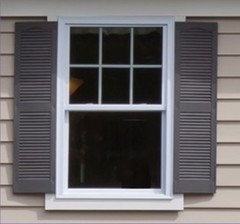

Many homeowners don’t even dare obstruct their big, beautiful windows by using window treatments! The window trim is very thin to make the glass and the sash as big as possible. The windows are sleek with thin frames and no grids. But with the vast majority of homes built in more traditional styles, many homeowners still yearn for the simple yet unique look of modern design. Modern style has been around for decades. Since traditional windows used grids in various ways, it should be no surprise that modern windows went in the opposite direction. Two-over-one windows are also common, with a single grille on the top sash and none on the bottom. One muntin divides the sashes, creating a classic four-by-four pattern. Groups of large windows - often awning, single-hung or double-hung - maximize the natural light and allow for ventilation.įarmhouse window trim is chunky and the window grilles are simple. Two-over-two grille patterns are also common in both valence grids and double-hung windows.įarmhouse style is built around function but doesn’t lack character. You might see panes with different colors (similar to stained glass), diamond grille patterns or small square grids creating a border around an unobstructed portion of the pane. Victorian-style windows are tall, helping to accentuate the high peaks of the home, and decorative. It’s the rare style that emphasizes asymmetry.


Victorian houses are well-known for their ornate and elaborate details. They look like a combination of two casement windows but offer different functionality. Sliding windows featuring the same Prairie grid pattern on both sashes are commonly used. With no sashes, they maximize the light and unobstructed space. This grid pattern often leaves small squares in the corners of the window.Ĭasement windows are the predominant windows used in Prairie-style homes. The grilles overlap and run along the edge of the glass, leaving more of the window unobstructed. Prairie-style window grids are quite different from the rectangular, symmetrical look of Craftsman and Colonial styles. Alternatively, some bungalows have Prairie-style grids on their windows. They are either elongated on the top sash or are used in a row of small squares across the top of the window. While many characteristics are the same, the window grille patterns differ. In window combinations, a transom window with square grilles spans the top of the other windows.Ĭraftsman bungalows are an offshoot of the Arts and Crafts movement. Either four or six rectangular grids are used on the top sash of Craftsman-style windows. But grids are only used on the top sash - the bottom is unobstructed. When the sashes don’t have the same number of grids, the top sash has more grilles than the bottom.Ĭraftsman homes use double-hung windows in a similar fashion. Nine-over-nine windows, where the grid pattern has nine square grids, is also common.

Typically, that’s six square or rectangular grids dividing each sash, which is known as a six-over-six window. The grids of Colonial windows are most often the same on both sashes. The sash of double-hung windows provides a similar symmetry to the glass. The home is rectangular and has the same number of windows on both sides of the entrance and both the first and second stories. The most popular styles can be traced back to the architectural era where they originated, but are still commonly found in older homes or new builds of many styles.Ĭolonial style is all about symmetry. You can even customize your own if you’d like. There’s a wide variety of window grid patterns. Even something as seemingly small as a window grille pattern is often associated with a specific style of home or architectural era. Architectural styles are defined by a number of core characteristics. The best case for grids is to match your home’s style. So the decision to go with grids or without them is all about aesthetics. Today, window grids ( also known as grilles or muntins) are largely decorative. This made it possible to ship window panes further without fear of breaking the glass. Window grids once served a crucial purpose: they held together multi-paned windows.


 0 kommentar(er)
0 kommentar(er)
